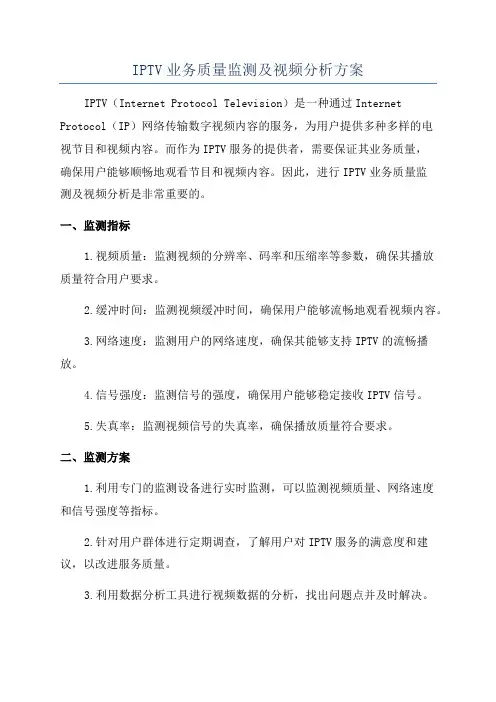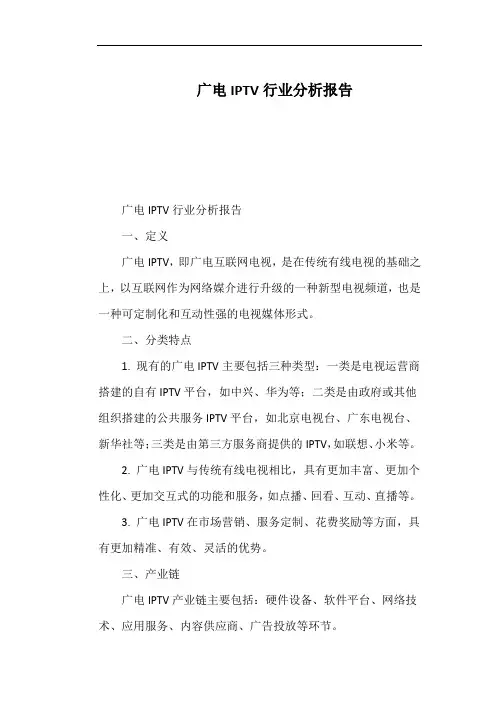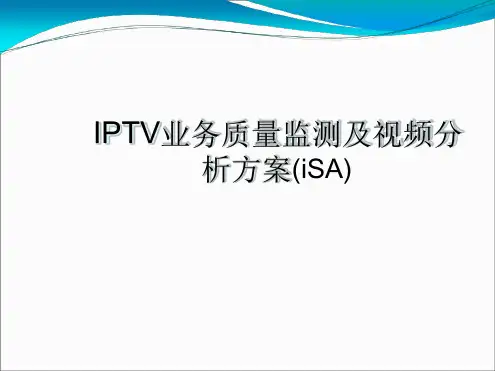IPTV行业媒体监测数据分析.pptx
- 格式:pptx
- 大小:337.35 KB
- 文档页数:13


IPTV业务质量监测及视频分析方案IPTV(Internet Protocol Television)是一种通过Internet Protocol(IP)网络传输数字视频内容的服务,为用户提供多种多样的电视节目和视频内容。
而作为IPTV服务的提供者,需要保证其业务质量,确保用户能够顺畅地观看节目和视频内容。
因此,进行IPTV业务质量监测及视频分析是非常重要的。
一、监测指标1.视频质量:监测视频的分辨率、码率和压缩率等参数,确保其播放质量符合用户要求。
2.缓冲时间:监测视频缓冲时间,确保用户能够流畅地观看视频内容。
3.网络速度:监测用户的网络速度,确保其能够支持IPTV的流畅播放。
4.信号强度:监测信号的强度,确保用户能够稳定接收IPTV信号。
5.失真率:监测视频信号的失真率,确保播放质量符合要求。
二、监测方案1.利用专门的监测设备进行实时监测,可以监测视频质量、网络速度和信号强度等指标。
2.针对用户群体进行定期调查,了解用户对IPTV服务的满意度和建议,以改进服务质量。
3.利用数据分析工具进行视频数据的分析,找出问题点并及时解决。
4.定期组织技术人员进行实地检查和测试,确保IPTV服务的正常运行。
5.与第三方机构合作,进行独立的服务质量检测,确保其客观性和公正性。
1.利用视频分析软件进行视频内容的分析,找出用户喜好和观看习惯,以提供更有针对性的内容。
2.对视频质量进行定量分析,找出问题点并进行优化,提高视频播放质量。
3.利用数据挖掘技术进行用户行为分析,提供个性化的服务,增加用户粘性。
4.对热门节目和内容进行分析,提前预测用户需求,并进行相应的安排和推送。
5.对广告内容进行分析,提高广告点击率和转化率,提高广告效果。
综上所述,进行IPTV业务质量监测及视频分析是非常重要的,可以提高IPTV服务的质量,提升用户体验,增加用户粘性,增强竞争力。
希望以上方案能够为IPTV服务提供者提供一些参考和借鉴,帮助其提升服务质量,获得更多用户认可和支持。


广电IPTV行业分析报告广电IPTV行业分析报告一、定义广电IPTV,即广电互联网电视,是在传统有线电视的基础之上,以互联网作为网络媒介进行升级的一种新型电视频道,也是一种可定制化和互动性强的电视媒体形式。
二、分类特点1. 现有的广电IPTV主要包括三种类型:一类是电视运营商搭建的自有IPTV平台,如中兴、华为等;二类是由政府或其他组织搭建的公共服务IPTV平台,如北京电视台、广东电视台、新华社等;三类是由第三方服务商提供的IPTV,如联想、小米等。
2. 广电IPTV与传统有线电视相比,具有更加丰富、更加个性化、更加交互式的功能和服务,如点播、回看、互动、直播等。
3. 广电IPTV在市场营销、服务定制、花费奖励等方面,具有更加精准、有效、灵活的优势。
三、产业链广电IPTV产业链主要包括:硬件设备、软件平台、网络技术、应用服务、内容供应商、广告投放等环节。
四、发展历程广电IPTV起步于2005年,起步阶段主要有政策研究和规划的阶段,2007年至2010年,是广电IPTV快速发展的阶段,主要推出了北京、上海、江苏等地的IPTV试点;2010年至2013年,是广电IPTV升级改造和整合的阶段,如中国联通、中国移动等运营商相继推出IPTV产品;2014年至今,广电IPTV进入全面发展阶段,产业规模不断扩大,市场份额稳步提升。
五、行业政策文件国家有关政策文件主要有《广电传输网络合作共建发展指导意见(试行)》、《关于深化广电传输网络改革的指导意见》、《关于推进广电网络三网融合的实施意见》等。
六、经济环境经济环境对广电IPTV的发展存在一定的影响,我国的经济增长和消费升级提高了居民收入和消费水平,增加了居民的消费需求和满足新的需求的营销渠道。
七、社会环境社会环境是广电IPTV兴衰的重要因素,广电IPTV运营商需要积极响应广大用户的需求和期望,保护网络环境和用户权益,才能获得更好的社会认同和改善。
八、技术环境技术环境是广电IPTV发展的核心基础,技术的发展与创新,如网络技术、编码技术、智能设备等都对广电IPTV行业的发展产生了重要的影响和推动作用。



IPTV(交互式网络电视)行业分析报告IPTV (Interactive Network Television) Industry Analysis ReportI. DefinitionIPTV refers to the distribution of television content through Internet Protocol (IP) networks, as opposed to traditional terrestrial, satellite, and cable television formats.II. Classification and CharacteristicsIPTV can be classified into three types: live IPTV, time-shifted IPTV, and video-on-demand IPTV.Live IPTV means accessing and watching real-time TV programming as it happens, while time-shifted IPTV is the ability to watch previously aired content at a later time. Meanwhile,video-on-demand IPTV allows subscribers to select and watch videos on demand. All of these can be accessed on a variety of devices, such as smartphones, computers, and televisions, and can even offer additional interactive features.III. Industry ChainThe IPTV industry chain includes content providers, networkoperators, middleware providers, service providers, and customers. Content providers are crucial, as they provide the content that is delivered through IPTV to subscribers. Network operators distribute the content over the IP network. Middleware providers supply the necessary software to manage and distribute content. Service providers offer the end-user services and support. Customers are the end-users who utilize the IPTV services to access TV content.IV. Development HistoryIPTV had its beginnings in the 1990s in France with a project called the Interactive Cable TV Télétel. Since then, the industry continued to experience development in many countries, with increasing consumer adoption as a result of advancements in technology and digitization.V. Industry Policy and RegulationsTo facilitate the growth and development of the IPTV industry, many countries have implemented policies and regulations. For instance, in China, the State Administration of Radio, Film, and Television (SARFT) issued a policy in 2009 to regulate the IPTV industry. Meanwhile, in the European Union, the European Commission established rules guiding IPTV players by issuing the Audiovisual Media Services Directive (AVMSD).VI. Economic, Social, and Technological EnvironmentThe IPTV industry is significantly impacted by the economic climate of different countries. Social factors, like consumer preferences and cultural values, also play a critical role, such as the importance of global events. The industry is driven by continuous technological advancements and innovations to deliver content to a variety of devices and ensure high-quality streaming experiences.VII. Driving Forces for Industry DevelopmentSeveral factors are driving the growth and development of the IPTV industry worldwide, including the rising trend of video consumption, growing demand for on-demand content, increasing penetration of internet-enabled devices, the increasing number of middle-class consumers, and the introduction of new technologies like 5G, artificial intelligence, and virtual reality.VIII. Industry StatusThe IPTV industry is experiencing rapid growth, with increasing adoption by consumers worldwide. In China, the number of IPTV users reached 200 million in 2019, whereas in the United States, there are approximately 28 million IPTV subscribers. The global IPTV market is expected to reach $80 billion by 2025.IX. Pain PointsThe IPTV industry still has pain points, such as a lack of standardization and interoperability, content security, copyrightprotection, and data security. Additionally, some players suffer from inadequate user base and revenue from subscribers.X. Development SuggestionsTo help address industry pain points, IPTV companies should focus on developing better content, enhancing user experience, optimizing business models, improving security measures, and strengthening collaboration and standardization.XI. Industry Trends and ProspectsWith continued advancements in technology and the rising popularity of on-demand content, IPTV is poised to experience sustained growth across the globe. Key trends include personalized and customized content, the integration of IPTV with social media, and collaborations between IPTV firms and traditional TV networks.XII. Competition LandscapeThe IPTV industry is highly competitive, with major players like Netflix, Hulu, Amazon Prime Video, and YouTube TV leading the pack. Regional players are also gaining market share, such as iQiyi in China and ZEE5 in India.XIII. Representative EnterprisesRepresentative enterprises in the IPTV industry include Netflix, Hulu, Amazon Prime Video, YouTube TV, Verizon, AT&T, China Telecom, Orange, Deutsche Telekom, and BT.XIV. SWOT AnalysisStrengths: Growing consumer adoption and global expansion.Weaknesses: Lack of standardization and interoperability and struggles with content and data security.Opportunities: Continued advancements in technology and a growing demand for customized and personalized content.Threats: Competition from traditional television providers and regulatory challenges.XV. Industry ConcentrationThe IPTV industry has a low concentration ratio, with several major players sharing the market. However, regional players are gaining ground, which could create more competition in the future.Overall, the IPTV industry is experiencing robust growth thanks to consumer demand and continuous technological advancements. Players in the industry should focus on enhancing user experience, optimizing business models, and improving security measures to access new heights.。


